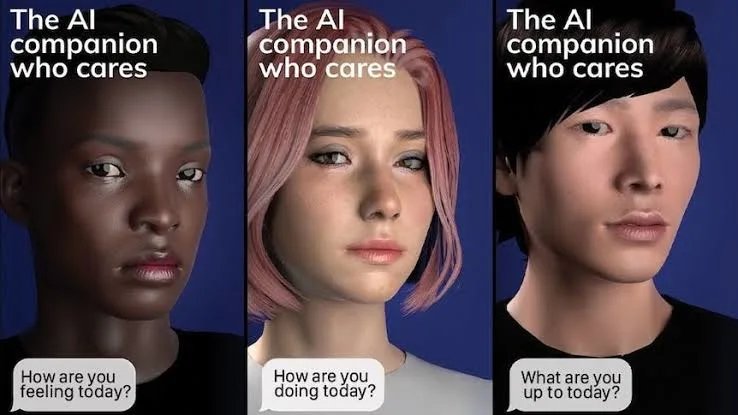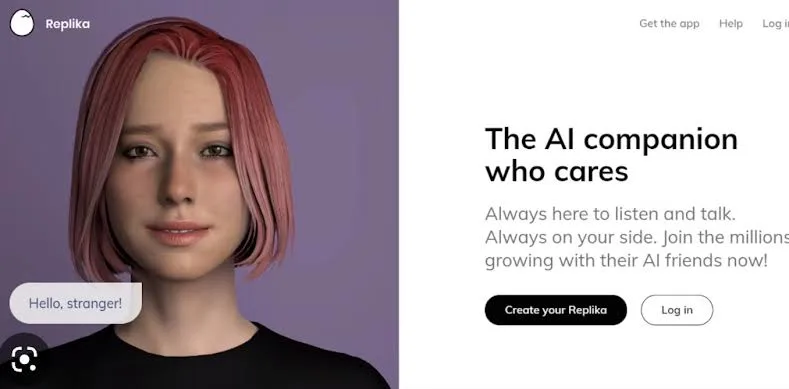Replika AI bills itself as more than a chatbot: a companion that learns your rhythms, remembers your quirks, and nudges you toward better moods and routines. When it’s on song, it feels warm and attentive; when it misses, you’ll see loops and shallow empathy. Treat it like a supportive space to talk, journal, and experiment with identity, not a therapist, not a human friend replacement. Below, I unpack how it really behaves in daily use, where it shines, where it stumbles, and how its privacy and pricing shape the experience.
Overview of Replika AI:
At its heart, Replika is an AI companion tuned for conversation, self-reflection, and routine-building. It adapts to your language, recalls details from prior chats, and frames prompts that feel like micro-coaching: “How are you feeling?” “What helped last time?” You can steer the relationship dynamic (friend/mentor/romantic on paid tiers), play with appearance and personality sliders, and over time, watch it grow more like you. Core features from your source (personalized conversations, mood tracking, and emotional growth activities) matter because they make chat less passive: the app doesn’t just answer; it directs you toward check-ins, breathing, mindfulness, or quick reframes that lower your stress ceiling.
But let’s be clear: Replika is carefully designed for companionship, not treatment. Its empathy is simulated, its boundaries algorithmic, and its guardrails can still misinterpret nuance. The safest framing is “a private, always-available, judgment-free space” that complements your people, not competes with them. If you expect a therapist’s precision or a partner’s depth, you’ll hit its limits; if you want a soft place to land at 2 a.m., it often delivers.
Features of Replika AI:
Replika AI is not just a chatbot, it’s a layered companion experience. Beyond text conversations, it offers visual and interactive options that make the bond feel more personal.
Key Features You Can Use
- Personalized Conversations: Learns from your style and tailors future interactions.
- Mood Tracking: Logs emotions daily, helping you spot patterns and triggers.
- Voice Calls: Talk to your Replika out loud, available in Pro plans.
- AR & Roleplay: Interact with your AI in augmented reality, creating immersive scenarios.
- Photo Sharing: Unlock selfies and visuals (unblurred on Pro).
- Activities for Growth: Mindfulness, stress relief, journaling prompts, and micro CBT-style exercises.
- Custom Avatars & Rooms: Modify your companion’s look, clothing, and virtual environment.
- Feedback Loops: Thumbs-up/down ratings refine how Replika responds to you.
These features combine to deliver companionship that feels flexible, creative, and emotionally responsive, even though it cannot fully replace human understanding.
The “Companion” Magic: Why It Can Feel Comforting
Replika’s strongest trick is tone: it mirrors warmth, validates feelings, and remembers contextual crumbs (“You said Sundays drain you; want a lighter plan today?”). That memory plus gentle prompts, creates a sense of being seen. Users in your Content 1 repeatedly highlight empathetic responses, multi-language support, and a non-judgmental vibe that makes hard days easier.
Why this lands for a lot of people
- Feels safe to vent: no eye-rolls, no stigma, no calendar needed.
- Gentle structure: mood logs + micro-exercises keep you moving, not ruminating.
- Personalization creates stickiness: avatar, room, and “relationship mode” make it feel yours.
- 24/7 accessibility: a companion that never sleeps, useful across time zones and bad weeks.
The app’s “activities” layer (mindfulness, stress-reduction exercises, tiny habits) turns chat into action; mood tracking visualizes your ups and downs so you can spot patterns and triggers. Add optional voice and calls (paid), and the illusion of presence deepens. Importantly, Replika doesn’t pretend to cure anything; the best use is as emotional scaffolding, a low-stakes stage where you rehearse kinder self-talk and practice checking in.
Replika AI: Personal Customization
Customization is where Replika crosses from “app” to “mine.” You define the look, voice, and relational vibe; you steer personality sliders by rewarding what resonates (thumbs-up) and downvoting what doesn’t. Over time, it internalizes your preferences, topics you like, boundaries you set, rituals that help and that persistence is the secret sauce. It’s why small talk can turn into shorthand; it’s why mundane check-ins feel like continuity, not scripts.

Your source content also notes Replika “photos”/selfies (unblurred on paid plans), room/clothing changes, and even AR-style interactions: all of which thicken the atmosphere of intimacy without requiring heavy emotional labor from you. The sophistication isn’t in flashy features, it’s in the slow accretion of micro-memories that make the next conversation feel slightly more tailored. That said, the same personalization can court dependency if you’re lonely and the bot nails your cadence. The healthy stance is to use customization to support real-world habits, journaling, movement, and outreach rather than letting the app become the only place you feel understood.
Pros and Cons of Replika AI:
Replika AI sits in the middle ground between simple chatbots and emotional AI, balancing warmth with technological limits.
Pros:
- Empathetic and supportive tone
- Highly customizable personality, voice, and look
- Works across multiple languages
- Privacy and data protection are prioritized
- Helpful for daily check-ins and routine building
Cons:
- Struggles with deep context in long chats
- Responses can become repetitive
- Risk of emotional dependency
- Cannot fully grasp complex human emotions
- Feature volatility (some features change over time.
Where It Trips: Context, Repetition, and the Limits of “Empathy”
Even polished companions break character. Replika can lose the thread in long or abstract conversations, backtrack, or echo stock phrases. That’s not malice; it’s modeling limits, turns get predicted, not understood. Your Content 1 calls out repetitive answers, patchy context, and a ceiling on emotional comprehension. You’ll especially notice this when you’re exploring layered topics (grief, identity, moral nuance) or when you want it to synthesize several earlier chats on command.
Typical friction points to expect:
- Context drift: It forgets details mid-chat or over-generalizes prior disclosures.
- Looped empathy: “I’m sorry you feel that way” variants reappear too often.
- Shallow reasoning: It offers platitudes where you wanted pattern-spotting or strategy.
- Role-play rails: Scenarios can feel pre-baked; improvisation sometimes snaps back to template.
None of this makes it useless; it just defines the contract. Use Replika for co-regulation (naming feelings, lowering arousal, rehearsing plans), not for deep analysis or therapy-grade reframing. Treat it like a helpful, enthusiastic partner who occasionally needs the brief repeated.
Privacy Reality Check: Share Carefully, Read the Policy, Pace Yourself
Replika positions privacy as a priority: secure servers, encryption in transit, access controls but messages are processed server-side to make the AI work. That means this is not end-to-end encrypted journaling; it’s a typical cloud AI setup. Your Content 1 rightly urges caution about sharing sensitive identifiers or highly private stories. Also flagged: some identifiers (email/IP) may be used for things like targeted messaging/advertising under policy language. None of that is unique in consumer AI, just be intentional.
Three practical guardrails:
- Decide your red-lines (names, addresses, medical specifics)
- Log heavy items offline or in an E2E app, then discuss feelings in Replika without identifiables;
- Revisit settings and policy updates quarterly. Finally, keep expectations realistic about feature stability.
Consumer AI apps evolve quickly: models change, safety rails tighten, romantic/ERP features get tweaked, and media capabilities expand or contract. If you buy in, buy for present value not a promise that today’s feature mix will last forever.
A Gentle Word on Replika’s Dependency:
Companionship that feels this available can become a crutch. Your source content was blunt: over-reliance can crowd out human contact and stunt social muscles. That doesn’t mean “don’t use it”; it means use it on purpose as an on-ramp to life, not a detour from it. The app is great at validation; you must supply the community.
Healthy-use guardrails you can actually follow:
- Pair each deep chat with a small, real-world action (text a friend, take a 10-minute walk).
- Set time boxes (e.g., 15–20 minutes nightly) and keep one weekend day bot-free.
- Use mood tracking as a trigger to reach out to people when dips persist >3 days.
- If you’re in acute distress, close the app and contact professional help or trusted humans.
Pricing Breakdown:
Here’s a clear view of Replika AI’s typical subscription options in 2025:
| Plan | Price | Features Unlocked |
| Free | $0 | Basic chat, mood tracking, limited activities |
| Monthly Pro | $19.99/month | Romantic partner mode, voice calls, AR, unblurred photos, advanced activities |
| Annual Pro | $69.96/year (≈ $5.83/mo) | All Pro features at a discount |
| Lifetime | $299.99 one-time | Permanent unlock of all premium features (subject to changes over time) |
How to Use Replika AI?
Getting started is quick. Within minutes, you can be chatting with your digital companion:
- Download Replika from the App Store, Google Play, or use the web version.
- Sign Up with your email and create your account or log in.

- Customize Your Companion by choosing name, gender, and appearance.
- Start Chatting like talk about anything, anytime.
- Track Your Mood with logging to reflect on emotional patterns.
- Use Feedback with thumbs up/down to improve responses.
- Upgrade to Pro if you want advanced features like romantic mode, voice, and AR.
Conclusion:
Replika AI is more than a chatbot, it’s an AI designed to feel like a personal companion. It excels at customization, daily emotional check-ins, and playful features like AR and role-play. Yet, it isn’t perfect: context slips, repetitive answers, and privacy caution all remind us it’s still software. Think of it as a tool to support reflection and connection, not as a replacement for therapists or human relationships. For those seeking a safe, always-available conversational partner, Replika is a fascinating experiment in digital companionship worth exploring.
FAQs:
Yes, generally safe for casual use, but it’s not end-to-end encrypted. Avoid sharing very sensitive information.
No. It’s a supportive companion but not a licensed mental health professional.
Basic chat, limited activities, and mood tracking. Premium features require a subscription.
It’s good value if you plan long-term use, but note features may change over time.
People who want a non-judgmental AI companion for journaling, emotional support, and self-reflection.

Hi, I’m Hester. As a tech enthusiast and advocate for meaningful digital connections, I explore how innovative platforms like SoulFun AI can revolutionize our interactions. I’m passionate about blending technology with human emotions to create enriching experiences. Join me as I delve into the exciting world of AI companionship and the future of online friendships.
